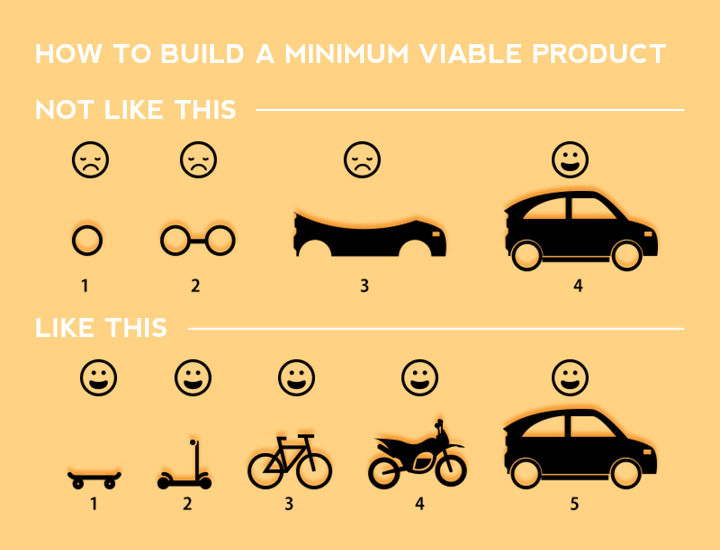Here’s a familiar story for many solo-developer founders/entrepreneurs.
First, you get an awesome idea.
Then—if you’ve been reading startup advice—you’ll try to validate that idea before building anything. Maybe you make a landing page and try to collect emails. Maybe you do some cold outreach and try to talk to customers. Either way, eventually you decide your idea is good enough to pursue and you decide to move on to the next stage.
So you build an MVP (Minimum Viable Product).
This takes some time, but is fun and rewarding. You get into flow and have a lot of fun building it. You’re cruising!

If you do build an MVP this is a great diagram to keep in mind
When your MVP’s ready, it’s time to put it out into the world, so you announce it on Product Hunt and Indie Hackers. You try to see if you can get traction on Hacker News and Reddit. You get a big spike in traffic, a bunch of positive input, maybe even some sign ups or sales. You’re stoked!
Then what happens?
Well, if your product is in the 99% of products that don’t magically take off virally, then not a whole lot. You’ll run out of new places to post. Your traffic numbers will trickle to a crawl. You’ll stop getting new sign ups. The world will move on. Even if people really like your product it will be almost impossible to get steady traffic and use.
Why is that? It’s because you don’t have reproducible organic reach. That is, a way to reach people consistently and with no effort on your part. The problem is that the people on Product Hunt and Hacker News aren’t hanging out there to use your product. They’re hanging out there to see what the flavor-of-the-day is, and then move on with their lives. Those real users, real customers, are much, much harder to get organically.
Where are they discovering things? The same place you do, obviously: Google. And maybe a few weirdos on Bing. But mostly the answer is “through search”. And that’s when you realize you need to figure out this SEO (Search Engine Optimization) thing that everyone’s talking about. And that’s where many developers give up, because SEO seems intimidating and hard.
The rest of this post is designed to convince you that that’s not true. I knew absolutely nothing about SEO six months ago, and my little SaaS (Software as a service) app for printable place card templates is now on the front page of Google for all kinds of relevant keywords. Here’s exactly how I did it.

Up, up and away! (source)
The Absolute Minimum Everyone needs to know about SEO
This is not a comprehensive guide to SEO, but you will need to know the absolute basics to understand my strategy. I learned almost all of this from Moz’s excellent beginners guide to SEO, and I recommend everyone invested in SEO read it.
But here’s the TL;DR as I understand it.
Your rank for a search term will be a complicated formula that takes in the following variables:
- The Domain Authority of your site. Which is how “important” Google thinks your site is, mostly determined by the number, diversity, and authority of other sites that link to it.
- The Page Authority of your content. The same thing but rather than for the whole site, for a particular page.
- The Relevancy of your content. As determined by the content on the page as well as the text of the links that link to the page.
- The Quality of your content. As determined by how people interact with your site. You get points for solving their problem / answering their question (determined by whether they come back to the search results page after visiting you or not).
So basically to build up SEO you need to do the following:
- Start with a quality product. If your product isn’t actually better than other options, make it better before focusing on SEO. It will be very hard to SEO a turd above a diamond on Google.
- Make your content relevant. By adding lots of text/content related to the terms you want to rank for. Google will look at the page titles, descriptions and headers the most so be sure to focus on those. Don’t overdo it as you can be penalized for something called “keyword stuffing”.
- Get a boatload of relevant backlinks from different places. You need other sites linking to your site, and doing it with text that you want to rank for. This will have a significant effect on your domain authority, page authority, and relevance for those keywords.
If you’re a developer I assume you can figure out 1 and 2. It’s getting the backlinks that usually trip people up. How do you get other domains to link to your site? And won’t that involve icky things like (gasp) cold emailing other bloggers / site owners to link to you via nefarious link trading/swapping agreements?
The surprising answer is not necessarily.
However, let’s get one thing out of the way first.
You Will have to Write
This strategy relies heavily on writing. If you don’t like writing you can potentially hire someone to write for you, but at its core you will need to produce content that you own. I don’t know how to generate links without content. It can probably be done, but might put you more in the icky networking/link-swapping territory.
But, if you’re like me and you don’t particularly want to network or link-trade (and also don’t mind writing) then read on.
Your SEO Strategy
Okay, here’s our SEO strategy.
- Write something useful or interesting
- Sneak in a link to your site with some text you want to rank for
- Get it published on a content platform.
Writing something interesting
I’ve written a bit about this before, but this is where you’re on your own. However, your secret weapon is that you don’t have to write anything relevant to your product. Just write about something you’re passionate about that you think others will get value from. Coding / technology is a good option for developer founders. I’ve mostly chosen to write about my self-education in entrepreneurship (including this post).
A small side note/caveat—writing about something relevant to your product is super valuable (particularly as a form of content marketing) and can really help with SEO—but it is not required, particularly for getting backlinks.
Sneaking in a link
Did you notice that I had a link to my SaaS product with the text “printable place card templates” in the first section of this post? You might have. But even if you did, did it noticeably detract from your experience of the article? I suspect not. And now I’ve just gotten one more backlink for a search term I’m working on.
Sneaking in links is much easier than you think—and when all else fails, you can always include something in the footer as an “about the author” note, as I did here on this totally unrelated blog:

When it’s hard to sneak in a link you can always include it in your bio.
Getting Published
Getting your content published by someone else sounds intimidating, but it’s actually much less difficult than you might think.
The secret principle that makes it easy to get published is what I call the symbiosis of content platforms. It’s a fancy name, but all it means is that your incentives and a content publisher’s incentives are often highly aligned. You want them to publish your content, and they want content to share with their readers. So everyone’s incentives are perfectly aligned. Symbiosis is a great world to be in!

In this analogy, the writers are the enterprising clownfish and the publishers are the home-providing anemones. (source)
In fact, most content platforms that aren’t the New York Times, Techcrunch, or Wired are actively seeking quality content for their site, and they’re happy to take articles from strangers as long as the quality is good and the content is relevant. All it takes is doing a little bit of research to find relevant ones for whatever you’ve chosen to write about.
The content platform that I’ve spent the majority of my efforts on is a very specific one: the Medium publication. Though the same principles would apply to any content publisher.
Two Quick Concepts to Understand
Before talking more about Medium publications I need to quickly explain two more concepts related to SEO.
What is rel=nofollow and why do you need to care?
The first is about link metadata, and in particular an attribute called nofollow. Nofollow is an attribute that can be attached to any link tag whose job is to indicate to a search engine that the link should not count towards SEO. They are automatically added to all links by some platforms (including Wikipedia and Medium)—typically to prevent SEO spammers.
Unfortunately, if they are added to your content then your backlinks are essentially worthless. D’oh!
What is a canonical link and why do you need to care?
The second concept is canonical links. These are used to prevent duplicate content on the Internet (which can significantly harm your SEO). Basically it is a page’s way of saying “I’m a copy of this other page”, and then links that go to the copy actually boost the SEO of the original page, instead of the copy.
Canonical links to your content should only help your SEO.
Medium and SEO
Okay, now that we understand nofollow and canonical links, we can talk about SEO and Medium publications. Here’s the nitty-gritty details:
- If you import a story into Medium from somewhere else, the canonical link for that story will be set to wherever you imported it from.
- Every other link in your content on medium.com (published directly on medium or a publication without a custom domain) will be slapped with a nofollow.
- However, links in anything published on a publication with it’s own domain (which most have) do not get slapped with a nofollow.
So to use Medium for your SEO benefit you should either be importing your stories from somewhere you want to SEO, publishing in a publication that has its own domain, or (ideally) both.
Some Practical Resources
Here are some other practical tips and resources to help get you going.
This publication leaderboard is a great resource for finding relevant Medium publications to submit to. Most publications have instructions for new submissions on their site or via Google.
As I mentioned already, the Moz Beginner’s Guide to SEO is a great way to invest a few hours in understanding the fundamentals of SEO.
Moz has a few other excellent tools on their site, including an excellent keyword explorer that will give you guidance on what keywords to go after and a site explorer that helps you see your sites domain authority (and compare to competitors).
Google has fantastic tools as well, including the search console, which will tell you how people are finding your site on Google, and the keyword planner which will provide rough search stats for any keywords.
I’m told that Bing has a keyword research tool as well, but really why are you using Bing?!?
Play the Long Game
Finally, just remember that SEO is a long, slow game. You will not see overnight results, but over time this strategy will pay off, and it is super fun and rewarding when it does. There’s no substitute for a steady stream of search traffic to your site, and (at least in my case) it’s really not as hard as you think to achieve that. Here’s my click stats from the last 60 days of following this strategy.

I started more than 60 days ago but it’s taken this long to really start seeing the payoff.
Good luck!